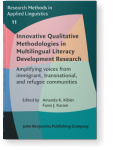Chapter 4
Communicating selves
Immigrant, emergent multilingual students’ voices and agency
through their multimodal artworks
This chapter features integrating multimodal data sources
(e.g., visual-arts and associated conversations) and critical
multimodal analysis as an innovative methodological approach.
Through multimodal literacies, we investigated how two immigrant,
emergent multilingual students communicated their dialogical self
with their multimodal artworks. This study is then used as a basis
for the methodological discussion about multimodal data sources to
give immigrant students agency to articulate their developing
identities as a part of their complex, transnational lived
experiences, which would have been missed by the researchers if only
monomodal, verbal data sources were utilized. Implications are drawn
around researchers’ professional learning of multimodal research
design and future research directions to create more equitable
engagement for emergent multilingual participants.
Article outline
- Introduction
- Overview of the study
- Theoretical framework
- Research context and participants
- Data collection and analysis
- Artworks and sketches
- Brief overview of the research findings
- Methodological discussion
- Rethinking research data sources: Issues about equity and integrating multimodal data
- Critical multimodal analysis
- Ethical considerations: Anonymity and ownership
- Implications
-
Notes
-
References
This content is being prepared for publication; it may be subject to changes.
